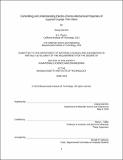| dc.contributor.advisor | Harry L. Tuller. | en_US |
| dc.contributor.author | Kim, Chang Sub,Ph.D.Massachusetts Institute of Technology. | en_US |
| dc.contributor.other | Massachusetts Institute of Technology. Department of Materials Science and Engineering. | en_US |
| dc.date.accessioned | 2019-09-16T16:42:59Z | |
| dc.date.available | 2019-09-16T16:42:59Z | |
| dc.date.copyright | 2019 | en_US |
| dc.date.issued | 2019 | en_US |
| dc.identifier.uri | https://hdl.handle.net/1721.1/122074 | |
| dc.description | This electronic version was submitted by the student author. The certified thesis is available in the Institute Archives and Special Collections. | en_US |
| dc.description | Thesis: Ph. D., Massachusetts Institute of Technology, Department of Materials Science and Engineering, 2019 | en_US |
| dc.description | Cataloged from student-submitted PDF version of thesis. | en_US |
| dc.description | Includes bibliographical references (pages 98-100). | en_US |
| dc.description.abstract | Surface exchange kinetics are a key indicator of performance for electrochemical devices including solid oxide fuel cells. Due to broad flexibility in dopant selection and concentration, mixed ionic-electronic conducting (MIEC) ABO₃ perovskite oxides have been extensively explored as model systems to understand oxygen surface exchange kinetics for solid oxide fuel cell (SOFC) electrodes. Traditionally, transport properties are examined as functions of type and concentration of aliovalent cations, requiring multiple samples, resulting in changes in multiple characteristics and properties, often unintended. Moreover, the perovskite oxides generally accommodate only oxygen vacancies and not interstitials. | en_US |
| dc.description.abstract | In this study, the type and concentration of ionic defects (oxygen vacancies vs interstitials) in MIEC layered cuprates (La₁.₈₅Ce₀.₁₅CuO₄) are systematically controlled, without change in cation doping or electronic conductivity, by electrochemical pumping of oxygen with and are analyzed through chemical capacitance, defect chemical modelling, and electrical conductivity. Oxygen surface exchange kinetics derived from electrochemical impedance spectra show a strong correlation with oxygen defect concentration increase, for both vacancies and interstitials. Key thermodynamic parameters, such as band gap energy (0.54±0.10 eV) and anion Frenkel enthalpy (0.618±0.074 eV) are derived. Evidence of oxygen vacancy ordering is observed from chemical capacitance analysis. Layered cuprates have multiple crystalline structure types - namely T, T*, and T' - which share similar chemistry, but are known to have different properties, such as oxygen diffusivities. | en_US |
| dc.description.abstract | Control of structure is systematically studied by using different substrates and seed layers, and by electrochemical pumping of oxygen. A dynamic and reversible structural change in layered cuprate thin films is discovered, for the first time, by oxygen nonstoichiometry control. Oxygen diffusivities of T and T' structures with the same cation chemistry (La₂CuO₄) are measured, for the first time, by oxygen isotope exchange experiment. The T-structured layered cuprate shows faster oxygen diffusion, but with higher activation compared to the T' variant. On the other hand, faster oxygen surface exchange kinetics exhibited by the T'- as compared to the T- type structured cuprate, as measured by thin film conductivity relaxation, is attributed to a lower enthalpy of oxygen interstitial formation. | en_US |
| dc.description.statementofresponsibility | by Chang Sub Kim. | en_US |
| dc.format.extent | 100 pages | en_US |
| dc.language.iso | eng | en_US |
| dc.publisher | Massachusetts Institute of Technology | en_US |
| dc.rights | MIT theses are protected by copyright. They may be viewed, downloaded, or printed from this source but further reproduction or distribution in any format is prohibited without written permission. | en_US |
| dc.rights.uri | http://dspace.mit.edu/handle/1721.1/7582 | en_US |
| dc.subject | Materials Science and Engineering. | en_US |
| dc.title | Controlling and understanding electro-chemo-mechanical properties of layered cuprate thin films | en_US |
| dc.type | Thesis | en_US |
| dc.description.degree | Ph. D. | en_US |
| dc.contributor.department | Massachusetts Institute of Technology. Department of Materials Science and Engineering | en_US |
| dc.identifier.oclc | 1117771525 | en_US |
| dc.description.collection | Ph.D. Massachusetts Institute of Technology, Department of Materials Science and Engineering | en_US |
| dspace.imported | 2019-09-16T16:42:56Z | en_US |
| mit.thesis.degree | Doctoral | en_US |
| mit.thesis.department | MatSci | en_US |
